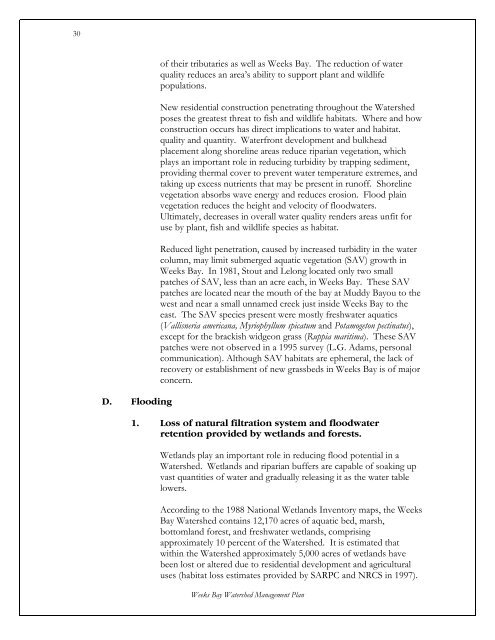Weeks Bay Watershed Project Management Plan - Mobile Bay ...
Weeks Bay Watershed Project Management Plan - Mobile Bay ...
Weeks Bay Watershed Project Management Plan - Mobile Bay ...
Create successful ePaper yourself
Turn your PDF publications into a flip-book with our unique Google optimized e-Paper software.
30<br />
D. Flooding<br />
of their tributaries as well as <strong>Weeks</strong> <strong>Bay</strong>. The reduction of water<br />
quality reduces an area’s ability to support plant and wildlife<br />
populations.<br />
New residential construction penetrating throughout the <strong>Watershed</strong><br />
poses the greatest threat to fish and wildlife habitats. Where and how<br />
construction occurs has direct implications to water and habitat.<br />
quality and quantity. Waterfront development and bulkhead<br />
placement along shoreline areas reduce riparian vegetation, which<br />
plays an important role in reducing turbidity by trapping sediment,<br />
providing thermal cover to prevent water temperature extremes, and<br />
taking up excess nutrients that may be present in runoff. Shoreline<br />
vegetation absorbs wave energy and reduces erosion. Flood plain<br />
vegetation reduces the height and velocity of floodwaters.<br />
Ultimately, decreases in overall water quality renders areas unfit for<br />
use by plant, fish and wildlife species as habitat.<br />
Reduced light penetration, caused by increased turbidity in the water<br />
column, may limit submerged aquatic vegetation (SAV) growth in<br />
<strong>Weeks</strong> <strong>Bay</strong>. In 1981, Stout and Lelong located only two small<br />
patches of SAV, less than an acre each, in <strong>Weeks</strong> <strong>Bay</strong>. These SAV<br />
patches are located near the mouth of the bay at Muddy <strong>Bay</strong>ou to the<br />
west and near a small unnamed creek just inside <strong>Weeks</strong> <strong>Bay</strong> to the<br />
east. The SAV species present were mostly freshwater aquatics<br />
(Vallisneria americana, Myriophyllum spicatum and Potamogeton pectinatus),<br />
except for the brackish widgeon grass (Ruppia maritima). These SAV<br />
patches were not observed in a 1995 survey (L.G. Adams, personal<br />
communication). Although SAV habitats are ephemeral, the lack of<br />
recovery or establishment of new grassbeds in <strong>Weeks</strong> <strong>Bay</strong> is of major<br />
concern.<br />
1. Loss of natural filtration system and floodwater<br />
retention provided by wetlands and forests.<br />
Wetlands play an important role in reducing flood potential in a<br />
<strong>Watershed</strong>. Wetlands and riparian buffers are capable of soaking up<br />
vast quantities of water and gradually releasing it as the water table<br />
lowers.<br />
According to the 1988 National Wetlands Inventory maps, the <strong>Weeks</strong><br />
<strong>Bay</strong> <strong>Watershed</strong> contains 12,170 acres of aquatic bed, marsh,<br />
bottomland forest, and freshwater wetlands, comprising<br />
approximately 10 percent of the <strong>Watershed</strong>. It is estimated that<br />
within the <strong>Watershed</strong> approximately 5,000 acres of wetlands have<br />
been lost or altered due to residential development and agricultural<br />
uses (habitat loss estimates provided by SARPC and NRCS in 1997).<br />
<strong>Weeks</strong> <strong>Bay</strong> <strong>Watershed</strong> <strong>Management</strong> <strong>Plan</strong>
















